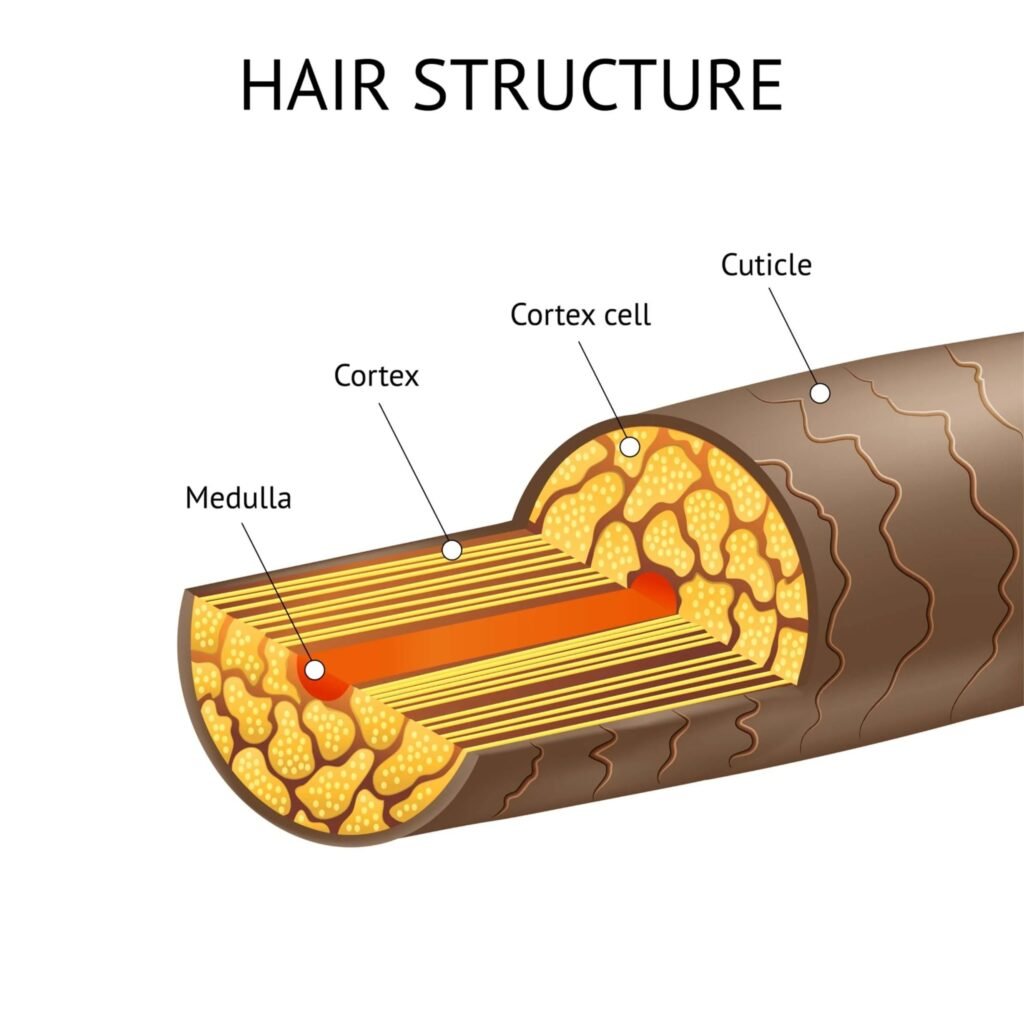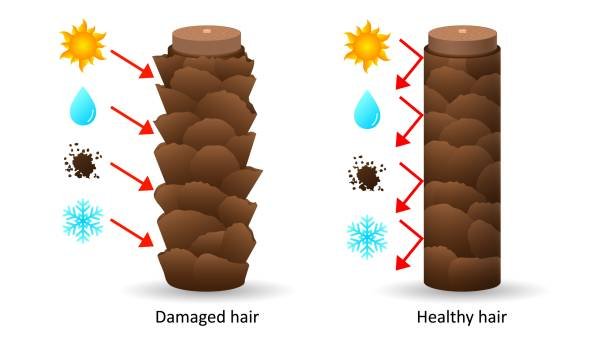
What Exactly Is Frizz?
Frizz is more than a minor inconvenience; it’s your hair telling you that something in its outer layer isn’t quite right. At its core, frizz happens when the protective barrier of your hair is compromised. This barrier, called the cuticle, normally lies flat, sealing in moisture and keeping the hair smooth. But when it is lifted or damaged, moisture from the air can slip inside the hair shaft.
Once this extra moisture enters, the hair begins to swell, changing its shape and texture. The result is that uneven, fuzzy appearance most of us dread. Although any hair type can experience frizz, some people battle it more frequently due to natural texture, hair porosity, and even climate.

The Structure of a Hair Strand
To understand why frizz happens, it helps to look at the anatomy of a single hair. Each strand is made of three distinct layers. The outermost layer, the cuticle, is formed of overlapping scale-like cells, much like shingles on a roof. Beneath the cuticle lies the cortex, which gives hair its strength, flexibility, and color. At the very center is the medulla, a soft core that is sometimes absent in fine hair.
The cuticle is the most important player when it comes to frizz. As long as its scales remain flat and intact, the hair reflects light evenly, feels smooth to the touch, and resists changes in shape. However, when the cuticle is lifted — either through damage or natural hair texture — the cortex becomes exposed. That exposure makes the hair more porous, meaning it absorbs and loses water more quickly. Porous hair responds dramatically to changes in humidity, swelling and contracting in ways that create frizz.
Why Some Hair Types Frizz More Than Others
Not all hair reacts the same way to humidity and damage. Curly and wavy hair, for example, has a natural tendency for the cuticle to lift in certain places because of the bends in the strand. Fine hair can also be vulnerable because it has a smaller cortex and fewer protective layers. Hair that is naturally high in porosity — or has become that way through chemical treatments, heat styling, or rough handling — is particularly sensitive.
This is why two people can walk outside on a humid day and have completely different hair results: one might see their style hold perfectly, while the other ends up with a cloud of frizz within minutes.
The Role of the Environment
The environment can either be your hair’s best friend or its worst enemy. Humid air, for instance, is packed with water molecules. When you step into this kind of climate, any raised cuticles on your hair will soak up the moisture like a sponge, causing the strands to expand and frizz. On the other hand, extremely dry conditions — like heated indoor air in winter — can pull moisture out of the hair, making it thirsty for hydration. Once that dry hair meets a humid environment, it will grab onto every drop it can, often with frizzy results.
Sunlight and UV rays also play a subtle but damaging role. Over time, they can degrade the proteins in the cuticle, leaving it rougher and more likely to lift. Even wind can contribute by causing constant friction between strands, lifting the cuticle layer little by little.
Daily Habits and Their Impact on Frizz
While genetics and environment are important, the way you care for your hair on a daily basis can be just as influential. Overwashing, for example, strips away the natural oils that keep the cuticle sealed and smooth. Rough towel drying creates friction, which can raise the cuticle and cause tangling. Skipping conditioner leaves your hair without the lubrication and protection it needs, making it more vulnerable to humidity. And heat styling without a protective barrier can cause permanent damage to the cuticle, leading to chronic frizz.
By adopting gentler habits — using microfiber towels, applying leave-in conditioners, and never skipping heat protection — you can dramatically reduce the frequency and severity of frizz.

The Science of Prevention
Preventing frizz comes down to protecting and sealing the cuticle. Hydration is key, because well-moisturized hair is less likely to seek moisture from the air. Strengthening treatments that contain proteins like keratin can help reinforce the structure of the hair, making it smoother and more resilient. Finally, anti-humidity products can form a protective layer around the hair, keeping excess moisture out even in challenging climates.
When all three factors — hydration, strength, and protection — are in place, frizz becomes much easier to manage, no matter your hair type or the weather conditions.
Final Thoughts
Frizz isn’t random; it’s a direct reflection of the health and structure of your hair. By understanding the science behind it, you gain the tools to prevent it. Protecting the cuticle, keeping your hair hydrated, and using targeted products when needed can make the difference between a style that collapses the moment you step outside and one that stays sleek and smooth all day.
This knowledge forms the foundation for any anti-frizz strategy, whether you lean toward natural methods, professional salon treatments, or carefully chosen hair care products.
💡 Still have questions? Head over to our Frizz FAQ for quick, expert answers.
